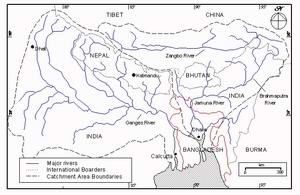 Last June 2004, engineers blocked the Yangtze River at the Three Gorges Dam filling the reservoir for a $25 billion hydroelectric project that is a point of pride in a country desperate for power but that critics fear will become an environmental nightmare. Hundreds of thousands of people have since been relocated from the area of Hubei province around the reservoir, which has swallowed cities, villages, factories and hospitals as well as some archaeological treasures.
Last June 2004, engineers blocked the Yangtze River at the Three Gorges Dam filling the reservoir for a $25 billion hydroelectric project that is a point of pride in a country desperate for power but that critics fear will become an environmental nightmare. Hundreds of thousands of people have since been relocated from the area of Hubei province around the reservoir, which has swallowed cities, villages, factories and hospitals as well as some archaeological treasures.
But because governments everywhere continue to build bigger and better dams, local people will inevitably be uprooted from their homes.
The assault on vulnerable, fragile sections of society is so complete that its sheer audacity has eroded our definition of justice and whenever a large dam is built, it poses serious threats to local populations.
 Of intimate concern to us, although it will not pose a threat to our people in that they will not be moved off of their property, it is nevertheless a threat with which we must deal, as the Chinese dams being built on the upper Brahmaputra, three times as large as the notorious Three Gorges Project on the Yangtse, will threaten our livelihood. But a better example may be China’s hydroelectric dam project in the region of Ngaba "Tibet Autonomous Prefecture" ("TAP"), Sichuan Province that has raised concern among Tibetans.
Of intimate concern to us, although it will not pose a threat to our people in that they will not be moved off of their property, it is nevertheless a threat with which we must deal, as the Chinese dams being built on the upper Brahmaputra, three times as large as the notorious Three Gorges Project on the Yangtse, will threaten our livelihood. But a better example may be China’s hydroelectric dam project in the region of Ngaba "Tibet Autonomous Prefecture" ("TAP"), Sichuan Province that has raised concern among Tibetans.
An official decree issued by the authorities informed the 17,000 local inhabitants living in the eight townships under Barkham County and Chuchen County in Sichuan Province that they shall be relocated within a period of three years.
All affected people do not go quietly however, and all over the world there have been examples where people have protested their forcible removal from their homes. In Hanyuan county when thousands of farmers came out to protest the building of a hydroelectric dam that will flood 100,000 people out of their homes it resulted in at least one death. Although an official announced the suspension of work on the dam project, China sent thousands of paramilitary police to quell the protests if only to show people the government is intent on maintaining social stability. But hundreds of farmers in the area were detained after they surrounded a high-ranking provincial official.
Why do large dams still excite such passions? After all, haven’t large dams over the past 70-80 years posed severe threats to indigenous peoples and other local populations around the world by dominant populations and yet succeeded in ousting the weaker groups in the race for resources. In other words this is not a new phenomenon. Within this context, large dams fall into a well-known pattern as countries embrace traditional western technology and though there are at present a number of international guidelines, agreements and conventions aimed at protecting indigenous and other politically weak people from exploitation by the dominating segments of society, including a United Nations resolution condemning the practice of forced eviction, no matter what is written in these agreements, conventions and guidelines, large dams are still being built in increasing numbers in the Third World. But the construction of a dam often means that a whole community needs to be relocated at the same time.
Although the problems being discussed mainly concern those living in the immediate vicinity of the dam, large dams also have their impact on populations living downstream, sometimes all the way to the estuary where the river meets the sea. This is partly due to the changes of water flow and water quality caused by the dam. Other problems for downstream populations frequently occur when a reservoir is created upstream of the dam to supply water for human consumption, irrigation, or industrial use for local consumption, as it usually deprives those downstream of their due. Yet governments continue to build them – why?, (The Bangladesh Observe, November 24, 2004).
Last June 2004, engineers blocked the Yangtze River at the Three Gorges Dam filling the reservoir for a $25 billion hydroelectric project that is a point of pride in a country desperate for power but that critics fear will become an environmental nightmare. Hundreds of thousands of people have since been relocated from the area of Hubei province around the reservoir, which has swallowed cities, villages, factories and hospitals as well as some archaeological treasures.
Of intimate concern to us, although it will not pose a threat to our people in that they will not be moved off of their property, it is nevertheless a threat with which we must deal, as the Chinese dams being built on the upper Brahmaputra, three times as large as the notorious Three Gorges Project on the Yangtse, will threaten our livelihood. But a better example may be China’s hydroelectric dam project in the region of Ngaba "Tibet Autonomous Prefecture" ("TAP"), Sichuan Province that has raised concern among Tibetans.